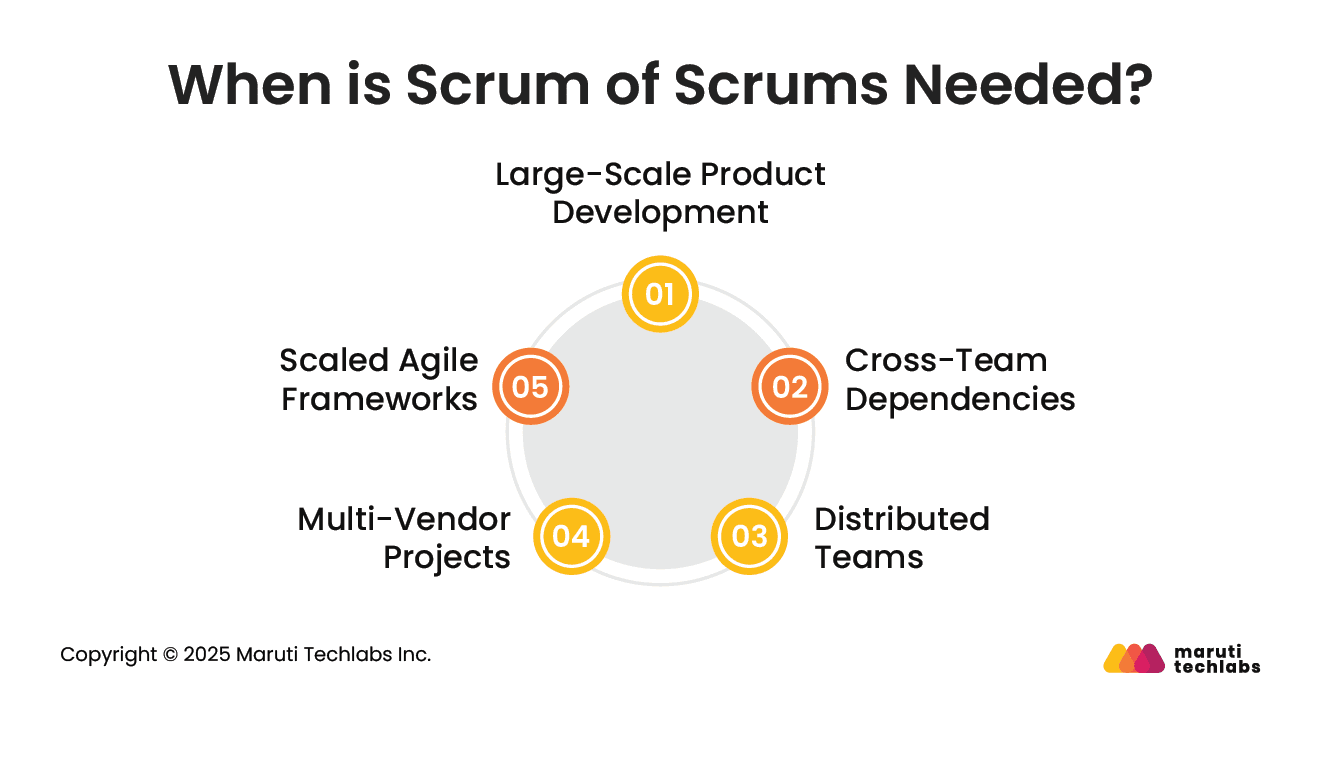Scrum of Scrums: Purpose, Agenda & Framework Explained
 Maruti Techlabs
Maruti Techlabs
Introduction
The number of people on your team can significantly impact your business. When you’re starting your business initially, it’s easy to keep track of everything that needs to be done. But as the team grows, things can get out of hand.
As organizations embrace Agile at scale, coordinating multiple Scrum teams becomes a growing challenge. That’s where Scrum of Scrums comes in. A proven framework that extends Scrum’s core principles to large-scale projects.
By facilitating structured communication across teams, Scrum of Scrums enables alignment, removes cross-team blockers, and enhances delivery speed without sacrificing agility.
According to the 17th Annual State of Agile Report by Digital.ai, Scrum continues to be the most popular team-level methodology: 63% of Agile users are team Scrum.
Its benefits include improved transparency, faster decision-making, and smoother integration of work across dependencies.
In this blog, we’ll explore how to run an effective Scrum of Scrums, complete with meeting agendas, key roles and responsibilities, best practices, and customizable scaling templates.
Whether you're an Agile coach or delivery manager, this guide will help you coordinate complex initiatives with clarity and cohesion.
History of Scrum of Scrums(SoS)
The Scrum of Scrums framework was first introduced by Jeff Sutherland and Ken Schwaber in 1996 while operating at the Lawrence Livermore National Laboratory. The original purpose of this framework was to coordinate the activities of eight business units with multiple product lines per business unit in a single development cycle.
Sutherland and Schwaber found that having separate scrum teams for each business unit impeded workflow within and across business units, so they experimented. They gathered all eight product teams into a single room. They had their work together by forming a meta-team or “Scrum of Scrums” to create an environment where independent teams could synchronize their efforts more efficiently.
Later, in 2001, Sutherland published this experience under the title “Agile Can Scale: Inventing and Reinventing SCRUM in Five Companies,” which mentioned Scrum of scrums for the first time.
What is Scrum of Scrums?
“Scrum of Scrums (SoS) is a scaling mechanism used to coordinate multiple Scrum teams working on the same product or project. It functions as a cross-team synchronization meeting, enabling teams to align on progress, dependencies, and blockers while maintaining agility at scale.”
Scrum of Scrums is designed to be a lightweight solution for scaling agile methods. The main benefit of the Scrum of Scrums approach is to provide a way to enhance communication by connecting people from different Scrum teams who need to collaborate and coordinate with each other.
The essential Scrum of Scrums’ purpose is that multiple teams are working on a single product, and there needs to be a way for all of these teams to communicate with each other.
It’s particularly relevant for organizations with teams across geographies and time zones because it provides a means for teams to synchronize their work, communicate any issues or delays, and coordinate planning activities.
According to the definition of Jeff Sutherland, “Scrum of scrums as I have used it is responsible for delivering the working software of all teams to the Definition of Done at the end of the Sprint, or for releases during the sprint.”
A Scrum of Scrums (SoS) is a meeting between two sprints, where the development team discusses their inter-team dependencies. The scaled agile framework is run by the development team members, who are best positioned to discuss inter-team dependencies and find a solution.
Scrum of Scrums helps deploy and deliver complex products by adapting transparency and inspection at a large scale. It enables scrum teams to work towards common goals and complete the project by aligning.
Participants present at the Scrum of Scrums answer similar questions like daily Scrum. For instance:
What has been the team’s progress since we last met?
What problems are the team facing, and can the other teams resolve them?
What tasks will the team carry out before the next meet?
There are various techniques by which you can implement the Scrum of Scrums. It could be a meeting within the team or with all teams. Therefore, scrum of scrum definition aims to get all teams in sync with each other so that any dependencies between teams have been identified and resolved.
What is the Purpose of Scrum of Scrums?
Scrum of Scrums exists to bridge communication gaps between teams in large-scale Agile environments. Its primary goals are to ensure coordination across teams, integrate deliverables effectively, and identify or resolve inter-team impediments early.
By promoting transparency and collaboration, it helps maintain a steady delivery flow and supports the Agile principle of adaptability, even at scale.
A Scrum of Scrums meeting can be a valuable way to communicate with organizations with different goals. Here’s how:
Organizations use this approach as the initial step to scale agile and organize the delivery of large, complex products.
The Scrum of Scrums supports the agile teams by enhancing their productivity and coordinating their work with other teams.
When problems arise in one part of a system, they can affect the rest of the system directly and indirectly. Scrum of Scrums provides an effective way to identify these issues and address them on time.
Through this meeting, representatives from each team can share updates about their progress and report on issues that may have arisen.
Scrum of Scrum meetings helps ensure that tasks are synchronized, and team members are kept up to date with the work remaining on their project.
Scrum-of-Scrum teams not only coordinate delivery but ensure a fully integrated product at the end of every sprint.
Scrum meetings are also helpful for solving problems and making decisions.
This meeting helps ensure transparency by providing everyone with the latest information on the project.
When is Scrum of Scrums Needed?
Scrum of Scrums becomes essential when multiple Scrum teams are working toward a shared goal and need structured coordination to avoid misalignment, delays, or integration challenges.
Here are key scenarios where Scrum of Scrums is needed:

1. Large-Scale Product Development
When a single product requires the efforts of several Scrum teams working in parallel, Scrum of Scrums ensures that progress remains synchronized and dependencies are managed proactively.
2. Cross-Team Dependencies
If teams rely on each other’s deliverables such as shared components, APIs, or services, SoS helps surface blockers early and fosters collaborative problem-solving.
3. Distributed Teams
In globally distributed environments, SoS provides a centralized communication rhythm, ensuring all teams stay aligned despite geographic or time zone differences.
3. Multi-Vendor Projects
When multiple vendors or departments contribute to a common initiative, Scrum of Scrums provides a neutral ground for aligning efforts and tracking integration points.
In organizations using structured scaling frameworks, Scrum of Scrums is a foundational ceremony for aligning teams at the program or train level.
In all cases, it fosters transparency, alignment, and faster issue resolution across teams.
How does SOS work?
Read More:- Scrum of Scrums: Purpose, Agenda & Framework Explained
Subscribe to my newsletter
Read articles from Maruti Techlabs directly inside your inbox. Subscribe to the newsletter, and don't miss out.
Written by

Maruti Techlabs
Maruti Techlabs
Maruti Techlabs is an award-winning product strategy, design, and development partner. We bring the strategic value of product development consultants, the technical expertise of product engineers, data and systems architects combined with the UX-first approach to early-stage startups and established ventures. With a rich & varied experience of 13+ years in software development & a global clientele, we do everything from materializing your ideas through rapid application development & improving processes via RPA and AI to streamlining customer support via chatbots. We believe that the best business comes from long-term relationships, and it’s why we strive to build long-term partnerships with our customers. Our team of highly skilled & experienced developers, designers, and engineers understand the market's pulse & specific business needs to provide custom product development solutions. Service Offerings: Product Development Rapid Prototyping Low Code/No Code Development MVP Development Data Engineering Computer Vision Machine Learning Natural Language Processing DevOps Cloud Application Chatbot Development Robotic Process Automation Business Intelligence Data Analytics Quality Engineering Awards & Recognition: Great Place to Work Top B2B IT Company - By Clutch Best Company to Work With - By GoodFirms India’s Growth Champion - Statista & Economic Times Most Reviewed AI Partners - By The Manifest We provide a people-centric work environment that enables our employees to: Enhance their professional & personal growth Use the latest technologies to make a positive impact Experience collaborative innovation with a focus on diversity & work-life balance Discover global opportunities to work & learn with industry leaders Our mission is to help our clients build future-proof and intuitive digital products while guiding them with the best processes & practices that help them undergo a successful digital transformation and scale sustainably.
